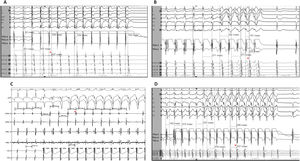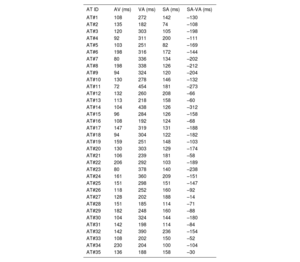
The stimulus-atrial minus ventriculo-atrial interval (SA-VA difference) during ventricular overdrive pacing of a supraventricular tachycardia is used to differentiate atrioventricular reciprocating tachycardia (AVRT) from atrioventricular nodal re-entrant tachycardia (AVNRT), but positive values have always been reported. In atrial tachycardia, the SA conduction is unrelated to the tachycardia mechanism, allowing for negative SA-VA values. We postulated that a negative SA-VA may serve as a criterion for atrial tachycardia in patients with supraventricular tachycardia and ventricular overdrive pacing from the right ventricular apex.
MethodsMulticenter data from ventricular overdrive pacing during atrial tachycardia (from 6 centers) and during AVRT and AVNRT (from 2 centers) were retrospectively and consecutively collected. The correct diagnosis was established using conventional criteria. The SA-VA difference was calculated for each case. The optimal SA-VA cut-off point for the diagnosis of atrial tachycardia was determined.
ResultsOut of 240 tachycardias analyzed, ventricular overdrive pacing succeeded in accelerating the atria to the pacing rate without tachycardia termination in 106 cases: 38 (36%) AVNRT, 33 (31%) AVRT, and 35 (33%) atrial tachycardias (all exhibiting long VA intervals). All atrial tachycardias had a negative SA-VA value, while all AVNRT and AVRT cases had positive SA-VA values. A SA-VA value lower than 0ms was the best cutoff, with an area under the curve of 1 and 100% sensitivity and specificity for the diagnosis of atrial tachycardia.
ConclusionsA negative SA-VA difference is a novel and accurate criterion for the diagnosis of atrial tachycardia with long VA intervals.
.
Keywords
Identify yourself
Not yet a subscriber to the journal?
Purchase access to the article
By purchasing the article, the PDF of the same can be downloaded
Price: 19,34 €
Phone for incidents
Monday to Friday from 9am to 6pm (GMT+1) except for the months of July and August, which will be from 9am to 3pm









